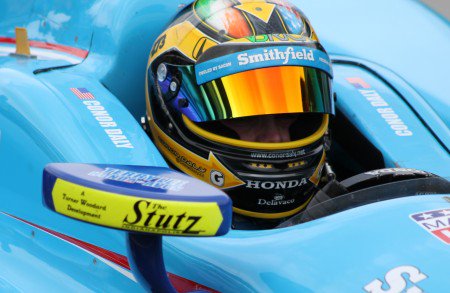
IndyCar Meet-and-Greet: Conor Daly
IndyCar’s great American hope attended Heritage Christian High School—most of the time.
Conor Daly graduated, he proclaims with a fist pump, but the Noblesville native guesses that, before finishing in 2010, he missed the Indianapolis school’s maximum allowance of 66 days per year while pursuing his racing dreams. He has received an education partly outside of the classroom, traveling around the world and climbing open-wheel’s ladder to both the Indy Lights and GP2 series, one step away from Formula One.
His youthful successes prompted IndyCar fans to declare him the chosen one, the savior of a sport that has recovered slowly from the turmoil and strife (read: “The Split”) that decreased the series’s popularity on a national stage.
Having hitched a ride with Schmidt-Peterson Motorsports for the 2015 Indianapolis 500, Daly returns to the same team that gave him a chance in Indy Lights four long seasons ago. Since then, people have begun to take notice. Daly says it is still a bit shocking when people recognize him, whether at the track or Fast Times Karting on the north side of Indy.
“It’s actually very surprising to see how many people know about me, know the story, know who I am,” Daly says. “What it does is … it just excites me to get back into a car and use the next opportunity that I have to make them proud.”
Jumping onboard with Schmidt-Peterson this year is a new sponsor, Smithfield Foods. The team also sponsors driver Aric Almirola in the NASCAR Sprint Cup Series, and Daly’s Indy 500 car shares the same iconic no. 43 and shade of Richard Petty blue. Daly believes the combination of sponsor engagement, speed, and recognition represents by far the best opportunity he’s gotten in his career.
To be sure, IndyCar fields a number of popular, winning drivers, such as Helio Castroneves, Tony Kanaan, and Scott Dixon. But the foreign-born veterans haven’t achieved the kind of household-name stardom that the Indy 500 once bestowed on greats like A.J. Foyt and Mario Andretti. American-born Ryan Hunter-Reay may have taken a dramatic victory in the 2014 Indianapolis 500, but that momentum slowly faltered. Even Danica Patrick, who finished third in the 500 in 2009 and became the biggest breakout star IndyCar has seen in decades, was regarded as a marketing invention by some racing “traditionalists.”
As a young, marketable, and talented driver, Daly has many fans’ hopes for the sport’s resurgence placed on him. With any open seat or rumored driver change in IndyCar, the social-media crowd clamors for Daly to be given the chance to compete at the highest level.
Daly has the pedigree. His father, Derek, ran the Indianapolis 500 six times and enjoyed a Formula One career that spanned five seasons. His stepfather, Doug Boles, currently president of the Indianapolis Motor Speedway, has served as a lawyer for racing sponsors and previously owned a stake in now-defunct Panther Racing.
But for Daly (and other talented drivers without regular rides), expense is a barrier. The Angie’s List Grand Prix of Indianapolis, which he sat out, would have required a sponsor to pony up nearly $200,000 for him to run, he says. Instead, he networked behind the garage and fought back the feeling of being jaded against the sport he grew up with.
“It’s really, really frustrating,” Daly admits. “Because of who I’ve seen get opportunities at certain points, people are like, ‘Wow, great to see someone get an opportunity.’ There aren’t many opportunities being given. It’s opportunities to pay to have an opportunity.”
“There are a lot of talented guys around,” IndyCar driver Graham Rahal says of Daly. Facing similar pressures as another young American driver in IndyCar (with a considerable pedigree of his own), Rahal has broken through and is on track for a career year after a second-straight podium finish at the Grand Prix of Indy. “Those who work the hardest on the sponsorship side are the ones who ultimately get the opportunities. I think he’s done a great job with his sponsor here, and hopefully they can see that through, see him do a little more.”
Even when not inside the car, racing is a see-and-be-seen sport. Racetracks double as networking conventions for drivers, and that proved vital for Daly earlier this season, when he was given the chance to substitute for Dale Coyne Racing and the injured Rocky Moran Jr. at a tough Long Beach street circuit. On incredibly short notice, he finished 17th and ran the second-fastest lap for a Honda during the race.
It was a pure opportunity—a shot at showcasing his driving ability, sponsorship commitments and the politics of motorsport aside. And Daly made the most of it.
“It’s just a different era,” he says. “I feel like there are about 100 different people who come up every day and tell me if I was racing 10 years ago, I would have been hired instantly, especially after Long Beach. But it is what it is. The race teams need money to go racing, and not many people are subsidizing it right now.”
Regardless, Daly remains confident that this time will be different. The timing may have never come together for him in the past, but with a new sponsor, a new look, and a new era of IndyCar at the Speedway, there is still reason to remain optimistic.






